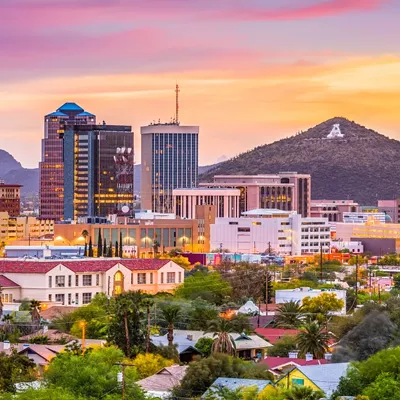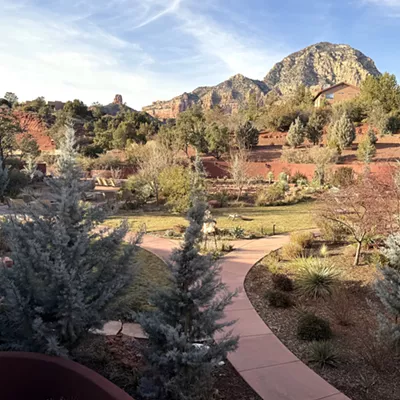The good news about buffelgrass--perhaps the only good news--is that you don't just have to sit and worry about it. There's plenty you can do to save the Sonoran upland ecosystem from being wiped out. Ecological soldiers like Marilyn Hanson of the Sonoran Desert Weedwackers need all the help they can get, and they dream of a fully aware and empowered citizenry ready to attack the plant wherever it grows.
"The Weedwackers can't pull it all," says Hanson.
To do your part, you must to learn to identify buffelgrass confidently--the last thing you want to do is pull up any beautiful, beleaguered native grasses. Fortunately, almost all of the natives look very different from buffelgrass and its obnoxious cousin, fountaingrass. While Sonoran grasses are diverse, they tend to be lacy and delicate in appearance, and none of them grows in dense, thatched stands the way buffelgrass does. (The Desert Museum link to the right has photos of the two or three native grasses that can be confused with Pennisetum. )
While buffelgrass varies in appearance depending on the time of the year and available water, it is not a subtle plant. You have seen it--along roadsides, in washes and vacant lots, and covering A Mountain and Tumamoc Hill.
Like fountaingrass, Pennisetum ciliare is a bunchy perennial that grows in dense clumps from a base that gets bigger every year. When it has water--after a wet winter, during the monsoon and along watercourses--it puts out a mass of green shoots, and to the untrained eye may look lush and pretty along the roadside. Poking up from the dishevelled central mass will be tall, bottlebrush-shaped flower spikes that resemble those of fountain grass, but are smaller and denser.
This spring, after months of drought, buffelgrass clumps resemble squashed golden haystacks 1 to 3 feet tall. The darker seeds are mostly gone from the flower spikes that stick up above a messy heap of rough, quarter-inch-wide blades.
Prepare to be horrified. Once you know what buffelgrass is, you'll see that it's everywhere in and around town. What do you do then?
Kill it, or get someone else to.
The Weedwackers' technique requires a strong back, at least one helper and a long pry-bar--locally known a caliche bar. (The city of Tucson's Department of Neighborhood Resources has a dozen of these available for checkout.) Spraying with Roundup only works when the plant is green.
· Get a caliche bar and some trash bags. Wear jeans, long sleeves, gloves and, if you're in the boonies, boots.
· Poke around each clump with the bar to check for snakes. If you find a snake, leave.
· Otherwise, jam the bar under the outside edge of the clump.
· Have your partner, who'll be wearing gloves, get her hands around the plant and pull up on it while you use the bar to lever out the root ball. You want the whole thing.
· Shake off the dirt, and put the plant in a trash bag. It's not a bad idea to leave it out in the sun so that any seeds can cook and become sterile.
· Check for shoots after the next rain--they'll be easy to pull.
And then you're done. Compared to Bermuda grass, buffelgrass is easy to clear.
Killing buffelgrass with herbicide is easier than pulling, especially on a large scale and on steep slopes, but many people don't like to spray. Roundup is expensive, and Monsanto, the company that makes it, is an unsavory outfit; you're putting chemicals into the environment; and after the plant's dead, you'll still need to get rid of it.
If you have buffelgrass on your property and can't pull it, or if you have it on a steep slope, spraying with Roundup is an option once the rains come. To repeat: Spraying dry buffelgrass does nothing--it must be green and growing to absorb Roundup. (Do NOT go out spraying in the desert. Do NOT get spray on other plants. Do NOT use it around water or in washes--it kills amphibians. And do be aware that one study found that the active chemical in Roundup causes damage to human placental cells.)
Physically getting rid of buffelgrass wherever you find it is the most important action you can take to stop its spread, but there's more to be done:
· If you'd like to help develop the scientific base of knowledge about invasive species by tracking their incursions, contact the Arizona-Sonora Desert Museum about their citizen scientist training.
· Talk to your neighbors and neighborhood association about local infestations. You can download brochures and other materials from the links below.
· Let politicians, public servants and land managers know that you're concerned about the unchecked spread of buffelgrass and other invasive species in the Sonoran Desert. Complain vigorously about infestations on public property.
FOR FURTHER INFORMATION
· Travis Bean of the UA Desert Lab gives presentations about the grass to interested groups.
· The Desert Lab Web site includes photos, a downloadable brochure, links and a five-minute video on identifying and removing the grass.
· The Arizona-Sonora Desert Museum's Web site offers detailed information about the grass and ASDM programs.
· To learn more about the city of Tucson's Habitat Conservation Plan, visit the city Web site.
· To join or support the Sonoran Desert Weedwackers, who pull grass in the Tucson Mountains one morning a month, contact Marilyn Hanson.
· An overview of ADOT's roadside program and contact information is also available.









